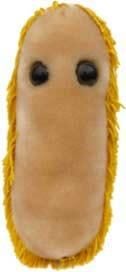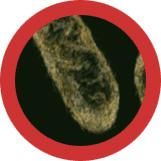Stomach Ache (Shigella)
Product Details
Additional Information
| Sizes | Giantmicrobes are based on actual microbes, cells, organisms and other critters, only 1,000,000 times actual size! Gigantic (GG) 40-60cm XL (XL) 25-38cm Original (PD) 12-20cm Minis (MM) 5-10cm each Keychain (KC) 5-10cm with clip |
|---|---|
| Materials | Plush from all new materials. Stuffed with polyester fiber fill. Surface washable: sponge with water & soap, air dry. |
| Packaging | Each plush microbe includes a printed card with fun, educational and fascinating facts about the actual microbe or cell. |
| Safety | Every product meets or exceeds U.S. and European standards for safety. For ages 3 and up. |
All about Stomach Ache (Shigella)
FACTS: A lot of stomach aches are caused by gas or acid in your stomach. But others are caused by microbes. Shigella is one of the more common culprits! (It is particularly common in developing countries and is a major cause of traveler's diseases.)
Shigella is named after a Japanese researcher named Shiga who discovered the bacterium in 1897. It causes an intestinal tract infection that produces abdominal cramps, fever, and diarrhea.
Shigella is extremely contagious. In fact, it is so contagious that if even 10 individual bacteria get into your system, you can become infected! As a result, over 140 million people are infected by Shigella every year. (It is responsible for 10 to 20 percent of the cases of diarrhea worldwide.)
The most important step to take if you are infected is to stay hydrated – though antibiotics can be used against the bacteria in the more severe cases. Better yet, avoid infection in the first place by washing your hands a lot!
| Name | Named after the scientist who discovered it. |
|---|
| Actual Size | 0.5 x 1.0 micrometers, which is about 100 thousand times smaller than a twinkie! |
|---|
| Where It Lives | Shigella species, such as S. sonnei and S. flexneri, spread through eating contaminated food, causing food-borne illness. It spreads from person-to-person by not washing hands properly after using the restroom. Infected people can spread it to others when handling food eaten by others. |
|---|
| Symptoms | Most Shigella species cause mild symptoms like slight fever, chills, stomach cramps, and sometimes bloody stool that can last up to a week. However, S. dysenteriae can cause severe diarrhea and vomiting that can be life-threatening. |
|---|
| Cure | Antibiotics and staying hydrated are the recommended treatments. |
|---|
| History |
First discovered by a Japanese microbiologist named Kiyoshi Shiga in 1897. Big Outbreaks: 1999: An outbreak in Sierra Leon caused over 3000 cases and 132 deaths in only two months! 2000: Over 400 people were infected along the West coast and no deaths. Recent Outbreaks: 2010: An outbreak occurred at a Subway restaurant in Illinois causing 21 cases. |
|---|
| Fascinating Facts | In 1997, a disgruntled laboratory employee at a large medical center contaminated muffins and donuts with Shigella in the staff room! His co-workers suffered shigellosis and a few had to be hospitalized, but no one died. |
|---|






